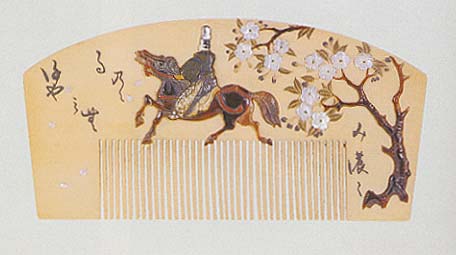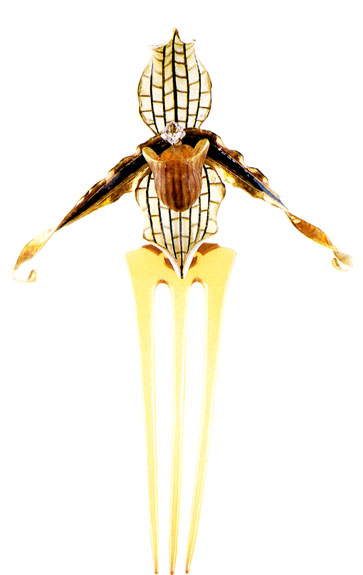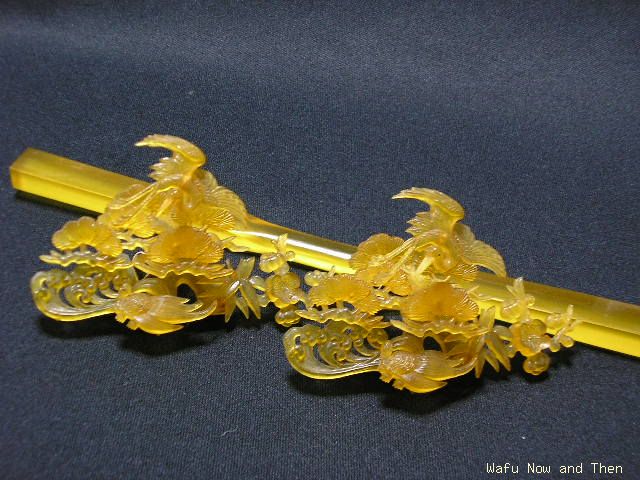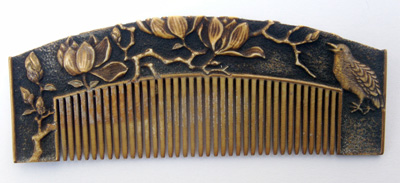On Ebay recently, there were two interesting auctions that deserve to be compared. The first was for a real tortoiseshell Edo set, consisting of a beautiful comb, blonde with brown markings, and a kanzashi with an attaching ornament of a plover bird on a coral branch. You may refer to my post I Love Japan to see a plover bird kanzashi ornament that belonged to a Japanese prince. The one for sale on ebay was only one little plover bird on one little branch, but who cares. Are we Japanese princes? No. ;-) This set was the real deal.
On May 21, it went on sale for a starting price of $490. For me, that was fine, but $490 is a high starting price for a hair comb on ebay. There is so much going on that amidst the noise, it’s very difficult for a seller to convince our audience that one piece is really worth $490 unless it has a name recognizable to Western buyers, like Tiffany, for example. Also, it’s very difficult to tell the difference between real shell and celluloid from a picture. The set did not sell the first time. It was relisted at at $250 and finally sold for $294 on May 31. Great buy. You may refer to item #190116714443.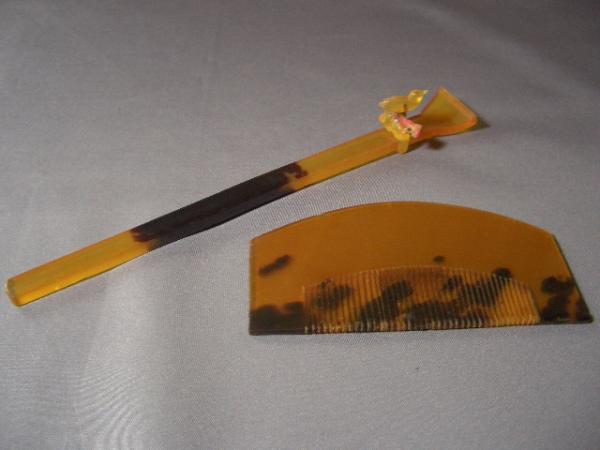
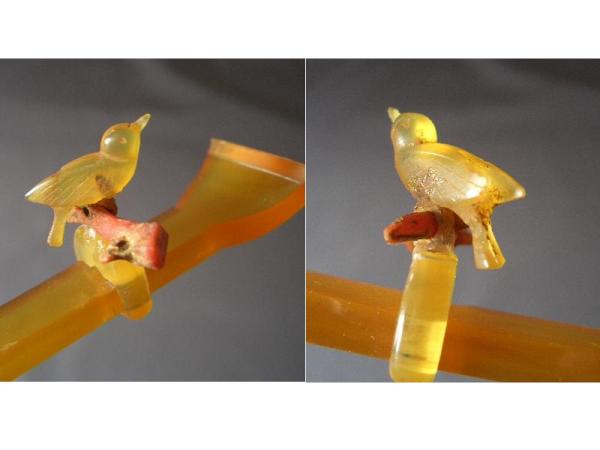
Meanwhile, another seller aquired a Japanese piece from the estate of a geisha. Her great grandchildren told the seller the kanzashi with two ornaments was Taisho and could be tortoiseshell. He repeated the story in his auction. At one point in the auction, the piece was at $522. My eyes widened when I saw this because this piece is one part of a celluloid Japanese wedding set. These sets were sold in Tokyo department stores in the 1940s. If anyone knows that they were made earlier, please let me know in the comments. The entire set goes for around $200 now.
I wrote to the seller. Nice man. My guess: the great grandchildren loved their family member and didn’t know because at one time these sets were made in shell. But the story sold. Amid the noise, the story got the attention of our audience and caused a bidding frenzy that far outweighed the value of the piece. One of the frenzied bidders withdrew, leaving the auction at $9.99, and the piece finally sold for $102.50 on June 7 — within the range of sanity, since it did come from the great grandchildren of the woman who actually wore it. You may refer to Item #120127400313.
For reference, here is an example of a complete imitation shell wedding set.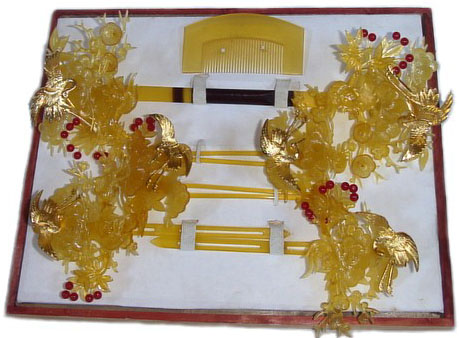
And here is the real thing. Source: a book of a famous Japanese comb collection, which is in a museum.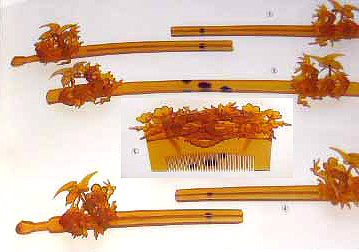
I think the “shell vs. celluloid in a picture” debate will go on forever, but authenticity is perhaps the most important feature of any antique purchase. Know your history, and good luck in your bidding! :-)
Category Archives: Japanese Hair Comb
I Love Japan :-)
Although I just did an article about kanzashi, these were so outstanding, I had to post. :-)
This blonde shell Sho-chiku-bai is beautifully balanced with plum, chrysanthemum, and bamboo. The artist even carved the chains on which the orchids hang out of shell. It was owned by the family of Prince Arisugawa Taruhito, who became the 9th head of one of the cadet branches of the Imperial Family of Japan in 1871, and was a career officer in Imperial Japanese Army. His collection is featured at the National Musuem of Japanese History.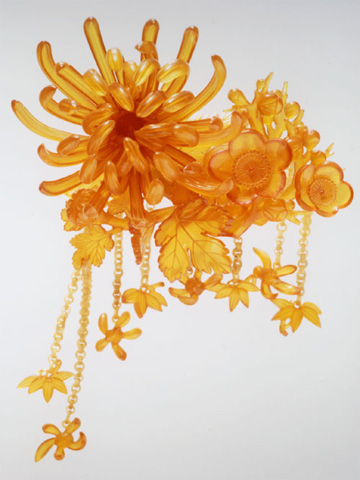
This tortoiseshell hairpin of plover birds flying over waves on a coral branch was also owned by Prince Arisugawa Taruhito. This one takes my breath away.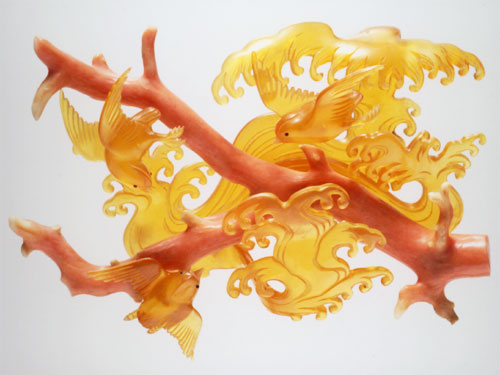
From the Nomura Shojiro Collection comes this Edo comb of a grasshopper busily eating while a larger animal looms. But are we seeing the animal’s horn, while his hungry eyes focus on that grasshopper? Or, does the line signify the larger animal’s tail, as he plods away completely unaware of the grasshopper’s existence. Japanese comb art plays with and mixes perspectives a lot, but this maki-e painting has all the players in one scene. The artist makes you imagine how each animal sees their world. In art school, teachers ask students, “What can you do with a line?” And I think this comb provides a wonderful answer because with one line, it goes from being beautiful to being great.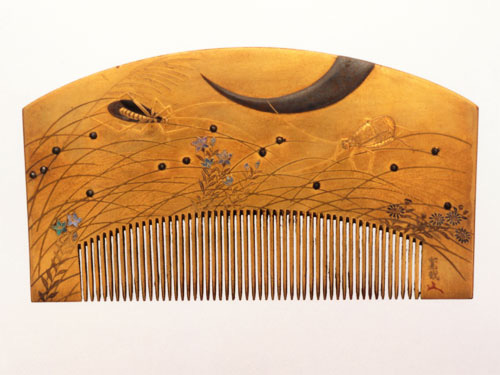
Kanzashi
Kanzashi are Japanese hair pins, which ornament a geisha’s nihongami, or coiffured black wig. Maiko, or younger geishas, wear more ornaments than the older, more experienced women. Different flowers are worn for each season.
Kanzashi are different than kushi (comb) or kogai (matching stick), even though all three ornaments serve the same purpose. I usually focus on antiques, but I feel modern kanzashi deserved some notice. Today, they are being made from vibrantly colored fabric and painted wood, as opposed to the tortoiseshell and silver of previous eras. The modern ones are quite affordable, too. So I thought I’d compare and contrast today and feature one of my favorite actresses: Zhang ZiYi.
These two tortoiseshell and pink-coral kanzashi ornaments are Taisho, c. 1920, and depict bamboo, plum and pine in an auspicious grouping, which the Japanese call “Sho-chiku-bai.” They were listed with a dealer who retired in 1999 at $300. I’d say that now, they were worth 3 times that because of the rarity of the design, quality, and condition. Tragically, I have no way of hunting down the owner, so I can kidnap her and force her family to give these to me as ransom. :-( ;-) But these are Maltese Falcons. :-)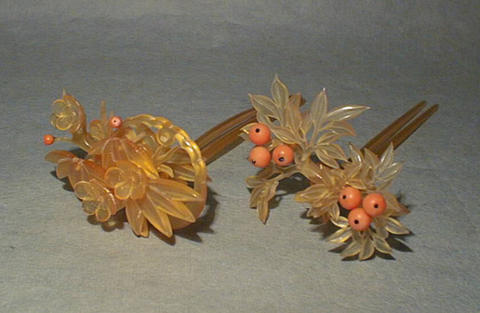
These beautiful tortoiseshell and coral hana kanzashi are tree peonies from the late Meiji Era (1868-1912). Hana kanzashi have the flower anchoring the pendants. One pendant is missing, but that’s no big deal. They are on sale on Trocadero for $890.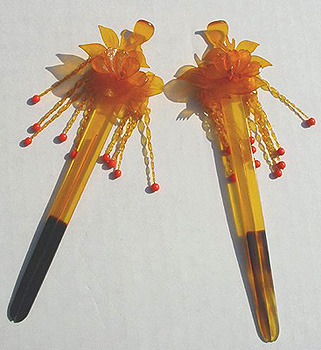
Bira bira kanzashi are “composed of metal strips attached by rings to the body of the ornament so that they move independently, pleasantly tinkling (which is sometimes accentuated by additional bells) or long chains of silk flowers called shidare.” (src: Wikipedia) Here is a gorgeous set from the Edo era. Value? Anything you can get it for. Wouldn’t matter. These are fabulous, and any dealer who had them would know that.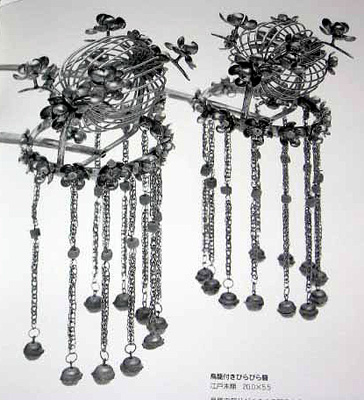
And here is a modern fabric wisteria. You can get them for $50, and these are the kind of kanzashi that Zhang ZiYi wore in “Memoirs of a Geisha.” Miss Zhang’s hana kanzashi were more complex than these, but you could get replicas of them if you really wanted to.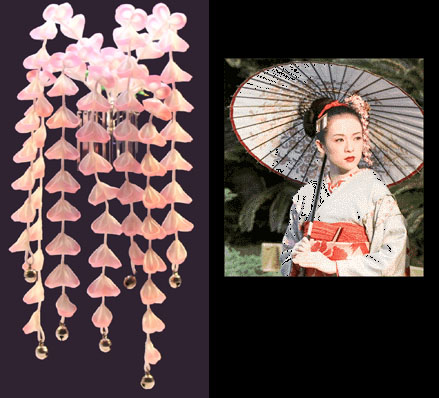
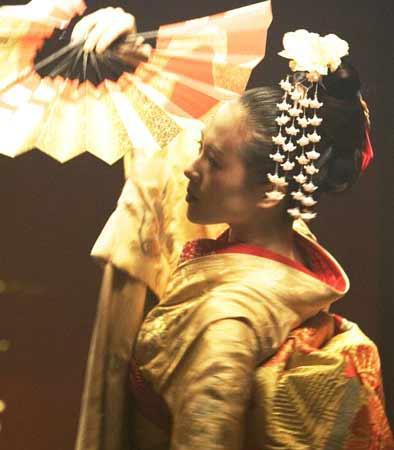
In addition to wearing geisha ornaments with such elegance, Miss Zhang also appears in diamond tiara combs when she attends award shows. I think she is fabulously beautiful.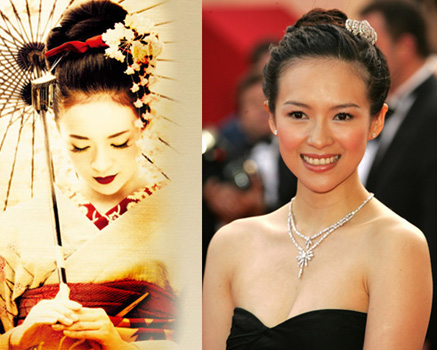
Crabs!
This kushi-kogai set sold on Trocadero, from JCollector, for $2200 a number of years ago. Ridiculous price. I had the money then. ;-) I had to sell this during a house sale that took too long, and mourn it still, but I wanted to share this and note its existence. It is made of tortoiseshell with a blue lacquer background. The crabs in the leafy pool are coral pink with brown eyes amid golden leaves. They have character and smile at you. Signed on both the kushi and kogai, this Taisho set (1912-1926) is a masterpiece. It seems Japanese combs awakened to color from the Meiji to Taisho periods, just as European combs did from the Victorian to Art Nouveau and Deco periods.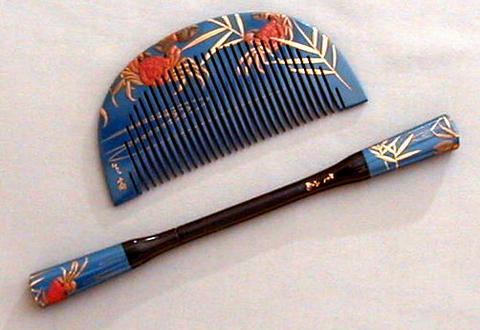
Edo Bird in Flight
Early Edo Japan is one of my two favorite periods of comb art. The other is French art nouveau. But recently, an Early Edo comb of a bird flying from a branch into the sunlight was featured on the web. What I love about this particular piece is that the paint is lighter where the sun is shining, so you get a perspective of the sunlight the bird is looking toward as it is jumps into flight. I’d say the piece is 18th-Century Edo, signed, in immaculate condition. You couldn’t put a price on this. It’s worth anything a collector would pay to get it.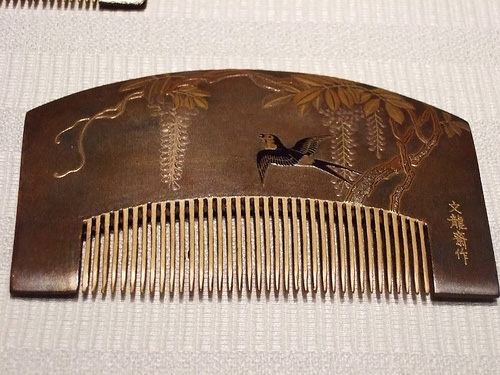
Some Lovely Things on Ebay
There have been some beautiful things listed recently, and I wanted to feature just a few of them. First is a lovely late Edo kushi whose Mt. Fuji landscape has great perspective and detail. The painting carries over the top edge of the comb. It is shell with gold maki-e, small applied gilt areas, and black lacquer lines. It was a Buy It Now for 435 UKP, and remained unsold.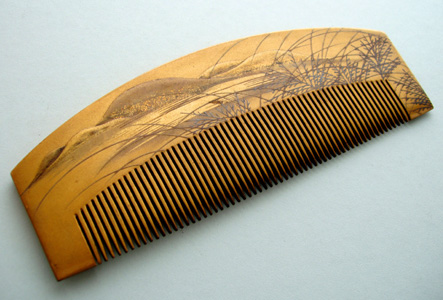
Next is an early Meiji tortoiseshell comb with beautiful raised gold carvings of a bird in a cherry blossom garden. It sold for $200 on October 18. Seller: webangelpb. Buyer: alain-t, a serious collector.
From 1850s England, a beautiful Georgian Sterling silver comb with a flower-filled urn at its crest sold for $155.50 on Oct 30. The seller was neatstuffdave. 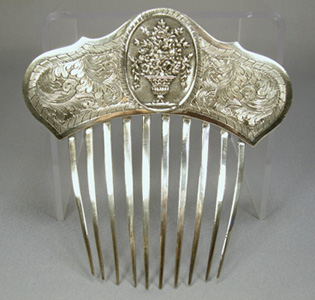
Last is a splendid Victorian Sterling hair comb with mythical figures in three cabachons. It has a maker’s mark and sold for $272.59 on Nov. 1. Buyer: myrnatoo, another serious collector. 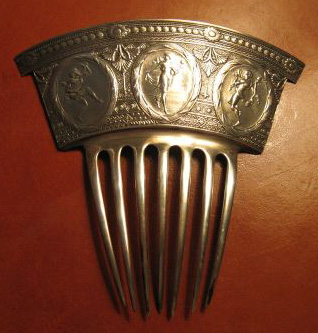
Hemp/Hibiscus? and Chimeras in Early Edo Japan
I am changing the text on this 18th-Century Edo comb about hemp because of an excellent, edifying comment by msctaiyang, a serious collector of Japanese hair combs. She said, “Regarding the hemp – it has been a medicinal herb in Chinese and Japanese medicine for centuries and to this day the treated seeds are used in many over the counter preparations. It is called Hua Ma Ren (ren means seed) and is used among other things to unblock the intestines. So hemp is really part of Japanese and Chinese culture, but in a much more utiltarian (and sensible) way than here in the States.” The comb is shell with black lacquer and gold paint. Although after seeing the flowers on a Japanese Hibiscus, the artist might have meant those.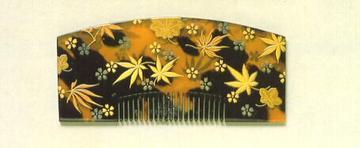
This wooden comb is 17th-Century Edo. You can tell by the size, artistic style, and subject. It’s one idea on a large comb canvas is a chimera behind a folding screen.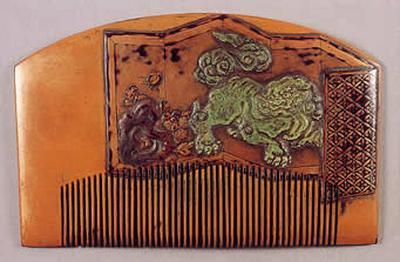
Rat and Bat Combs
I think every animal has appeared on a hair comb at one time or another. A friend of mine has an ivory rat comb! In what category should I show that? What about with a kanzashi bat?
Ivory Comb, English. c. 1880.
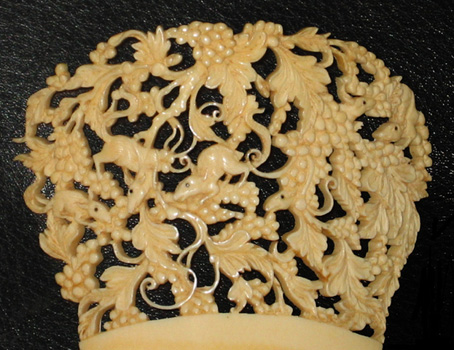
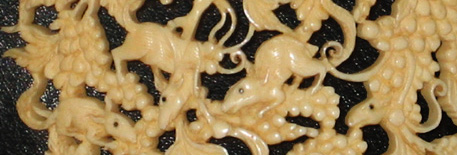
Tortoiseshell kanzashi, bat, c. 1880.
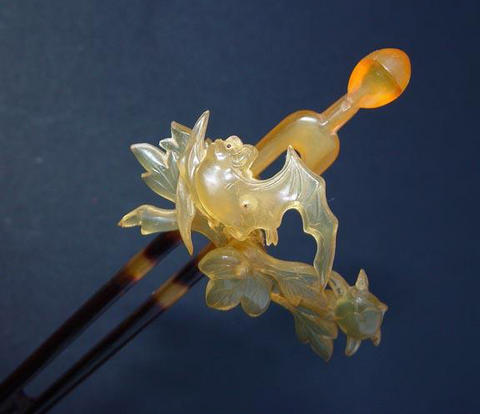
For The Birds
Man’s love affair with creating birds started with the earliest cave paintings. They are everywhere, and have always been a major theme in comb making. Recently, a beautiful ivory bird comb, Chinese c.1870, sold for $350. It got me thinking about doing a collection of bird combs on the blog. A friend of mine graciously sent me pictures of bird combs in her private collection. I own two bird combs, and there is a remarkable swallow comb at The Tadema Gallery in London. So here they are… the birds.
Mythical Bird on Edo Kogai stick, c. 1850
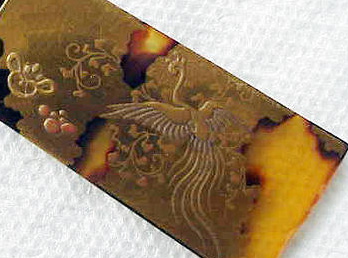
Ivory bird comb, Chinese, c.1870, sold Sept. 30, 2006 for $350, ebay.
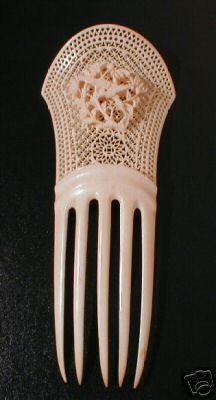
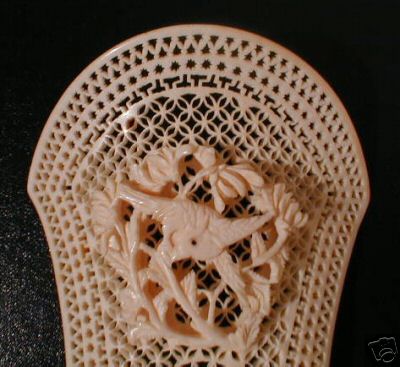
Ivory Bird on a bamboo tree, Chinese, c. 1870, a private collection.
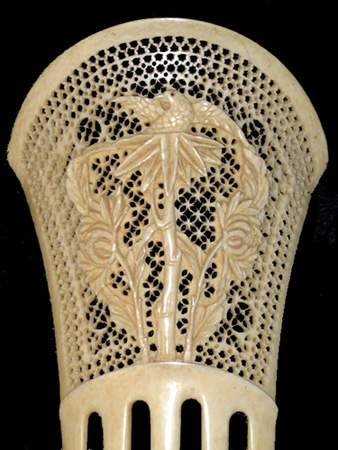
Tortoiseshell Bird on a stick, Italian, c.1870, my private collection.
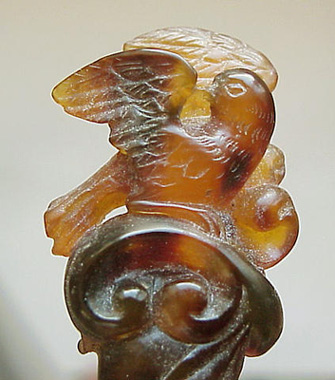
Ivory birds in a flower garden, Chinese, c. 1880, a private collection
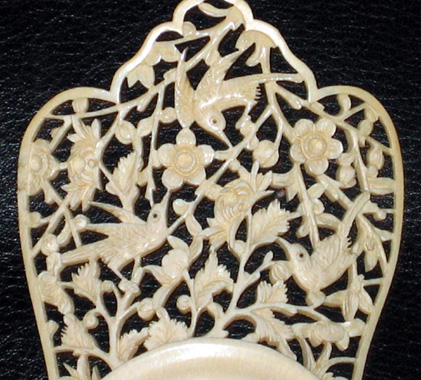
Black Crow on a Meiji Kushi, c. 1890
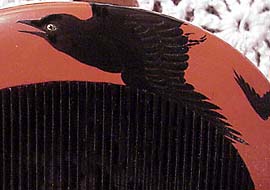
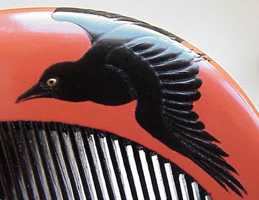
Silver filigree, micromosaic decoration, Italian, c. 1898.
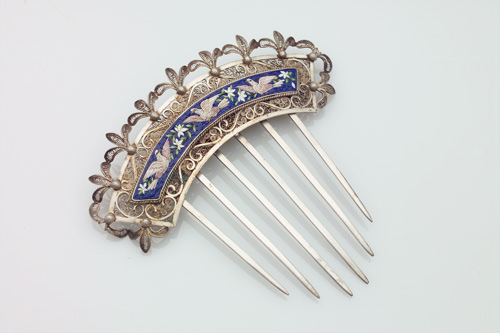
Swallow Comb, c. 1900, gilded silver and plique-a-jour enamel, from the British Arts and Crafts period, The Tadema Gallery, London. The price range for this comb is 2,500 to 5,000 British Pounds Sterling.
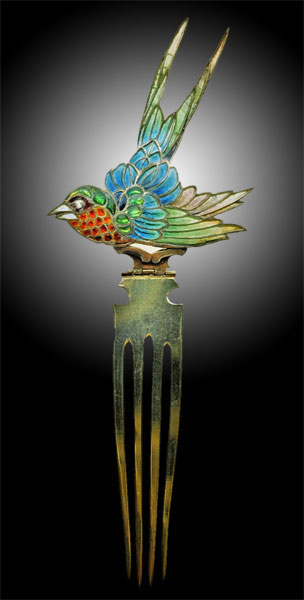
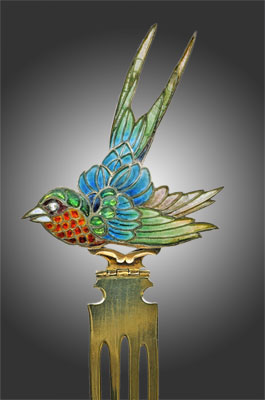
Three art deco parrot combs, celluloid, c. 1920, a private collection.
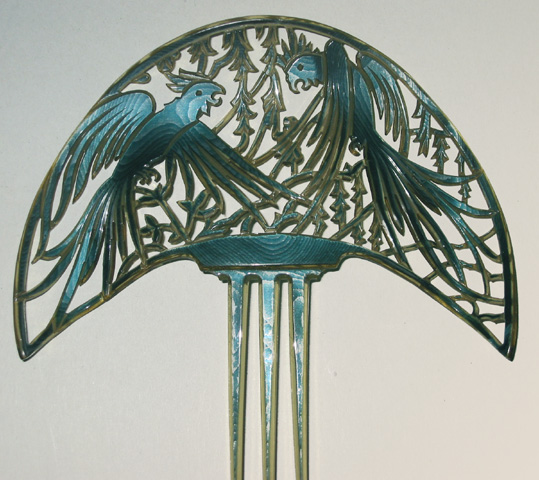
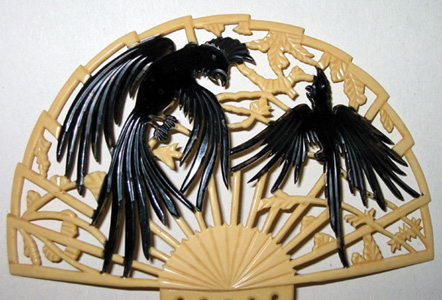
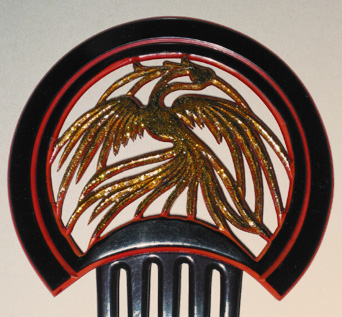
My Favorite Combs
Two historical periods created my favorite combs: Edo Japan and Art Nouveau France. The artistry embodies two completely different concepts, one painting and inlay on a flat ivory surface, the other an orchid sculpture or horn, ivory and glass made by Rene Lalique with his own hands. Examples:
